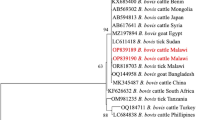Abstract
The purpose of this study was to determine whether dogs develop acquired resistance to adult Ixodes scapularis infestation in an experimental model. Five dogs were each infested with ten mating pairs of ticks every week for 7 consecutive weeks, another five dogs were each infested with ten mating pairs once every 2 weeks for 10 weeks and four dogs served as controls not exposed to ticks. All ticks were allowed to feed to repletion and were collected only after dropping from the host. Several variables were measured to determine the extent of blood feeding success. Regression analysis indicated that the engorgement success, survival and mean tick engorgement weight declined with repeated infestation in both groups of dogs (p<0.05). Tick oviposition as well as the F1 viability declined with each successive infestation in both groups. These results suggest that repeated infestation with I. scapularis elicits a protective immune response against tick feeding and could serve as a limiting factor in the spread and transmission of Borrelia burgdorferi.
Similar content being viewed by others
References
Ackerman S., Claire F.B., McGill T.W. and Sonenshine D.E. 1981. Passage of host serum components, including antibody, across the digestive tract of Dermacentor variabilis (Say). J. Parasitol. 67(5): 737–740.
Allen J.R. 1973. Tick resistance: basophils in skin reactions of resistant guinea pigs. Int. J. Parasitol. 3(2): 195–200.
Askenase P.W., Bagnall B.G. and Worms M.J. 1982. Cutaneous basophil associated resistance to ectoparasites (ticks). I. Transfer with immune serum or immune cells. Immunol. 45, 501–511.
Askenase P.W., Hayes J.D. and Hayden B.J. 1976. Antibody-mediated basophil accumulations in cutaneous hypersensitivity reactions of guinea pigs. J. Immunol. 117(5): 1722–1730.
Bagnall B.G. and Rothwell T.L.W. 1974. Responses in Guinea-pigs to larvae of the tick Ixodes holocyclus. Proceedings of the third International Congress of Parisitology. Vol. 3, 1082–1083.
Ben-Yakir J., Fox J.C., Homer J.T. and Barker R.W. 1986. Quantitative studies of host immunoglobulin G passage into the hemocoel of the ticks Amblyomma americanum and Dermacentor variabilis. In Morphology, physiology and behavioral biology. J.R. Sauer and J.A. Hair (eds), pp 329–341, Wiley, New York.
Brown S.J. and Askenase P.W. 1983. Immune rejection of ectoparasites (ticks) by T cell and IgG1 antibody recruitment of basophils and eosinophils. Fed. Proc. 42(6): 1744–1749.
Brown S.G. and Askenase P.W. 1985. Rejection of ticks from guinea pigs by antihapten-antibody-mediated degranulation of basophils at cutaneous basophil hypersensitivity sites: role of mediators other than histamine. J. Immunol. 134(2): 1160–1165.
Burgdorfer W., Barbour A.G., Hayes S.F., Benach J.L., Grunwaldt E. and Davis J.P. 1982. Lyme disease—a tick-borne spirochetosis? Science 216: 1317–1319.
Chinzei Y. and Minoura H. 1988. Reduced oviposition in Ornithodoros moubata (Acari: Argasidae) fed on tick-sensitized and vitellin-immunized rabbits. J. Med. Entomol. 25(1): 26–31.
Girardin P. and Brossard M. 1990. Rabbits infested with Ixodes ricinus L. adults: effects of a treatment with cyclosporin A on the biology of ticks fed on naive and immune hosts. Ann. Parasitol. Hum. Comp. 65(5–6): 262–266.
Kemp D.H., Pearson R.D., Gough J.M. and Willadsen P. 1989. Vaccination against Boophilus microplus; localization of antigens on tick gut cells and their interaction with the host immune system. Exp. Appl. Acarol. 7: 43–58.
Lee R.P., Jackson L.A. and Opdebeeck J.P. 1991. Immune responses of cattle to biochemically modified antigens from the midgut of the cattle tick, Boophilus microplus. Par. Immunol. 13: 661–62.
McTier T.L., George J.E. and Bennett S.N. 1981. Resistance and cross-resistance of guinea pigs to Dermacentor andersoni Stiles, D. variabilis Say, Amblyomma americanum Linneaus, and Ixodes scapularis Say. J. Parasitol. 67: 813–822.
Manohar G.S. and Banerjee D.P. 1992. Effects of immunization of rabbits on establishment, survival and reproductive biology of the tick Hyalomma anatolicum. J. Parasitol. 78(1): 77–81.
Oliver J.H., Owsley M.R., Hutcheson H.J., James A.M., Chen C., Irby W.S., Dotson E.S. and McLain D.K. 1993. Conspecificity of the ticks Ixodes scapularis and I. dammini (Acari: Ixodidae). J. Med. Entomol. 30(1): 54–63.
Rechav Y., Spickett A.M., Dauth J., Tembo S.D., Clarke F.C., Heller-Haupt A. and Trinder P.E. 1992. Immunization of guinea pigs and cattle against Rhipicephalus appendiculatis ticks using semipurified nymphal homogenates and adult gut homogenate. Immunology 75: 700–706.
Sonenshine D.E. 1993. Biology of Ticks, Oxford University Press, New York, Vol. 2, 305 pp.
Tembo S.D. and Rechav Y. 1992. Immunoization of rabbits against nymphs of Amblyomma hebraeum and A. marmoreum (Acari: Ixodidae). J. Med. Entomol. 29(5): 757–760.
Trager W. 1939. Further observations on acquired immunity to the tick Dermacentor variabilis Say. J. Parasitol. 25: 137–139.
Walker A.R., Fletcher J.D. and Todd L. 1990. Resistance between stages of the tick Rhipicephalus appendiculatus (Acari: Ixodidae). J. Med. Entomol. 27(6): 955–961.
Wheeler C.M., Coleman J.L. and Benach J.L. 1991. Salivary gland antigens of Ixodes dammini are glycoproteins that have interspecies cross-reactivity. J. Parasitol. 77(6): 965–971.
Wikel S.K. and Allen J.R. 1976. Acquired resistance to ticks. Passive transfer of resistance. Immunology 30: 311–316.
Willadsen P. 1980. Immunity to ticks. Adv. Parasitol. 18: 293–311.
Willadsen P. and McKenna R.V. 1991. Vaccination with ‘concealed’ antigens: myth or reality. Par. Immunol. 13: 605–616.
Willadsen P., Wood G.M. and Riding G.A. 1979. The relation between skin histamine concentration, histamine sensitivity, and the resistance of cattle to the tick, Boophilus microplus. Z. Parasitenkd. 59(1): 87–93.
Author information
Authors and Affiliations
Rights and permissions
About this article
Cite this article
Gebbia, J.A., Bosler, E.M., Evans, R.D. et al. Acquired resistance in dogs to repeated infestation with Ixodes scapularis (Acari: Ixodidae) reduces tick viability and reproductive success. Exp Appl Acarol 19, 593–605 (1995). https://doi.org/10.1007/BF00048814
Issue Date:
DOI: https://doi.org/10.1007/BF00048814




